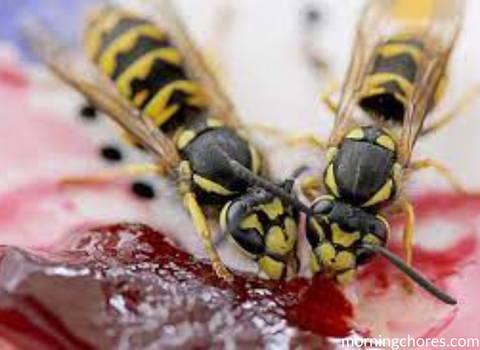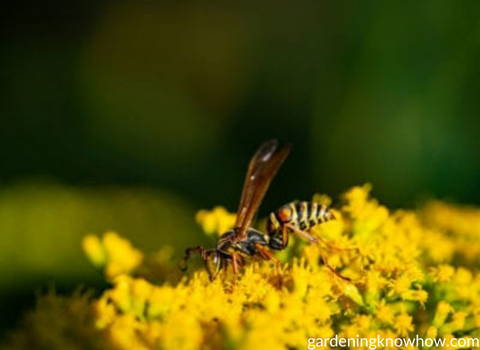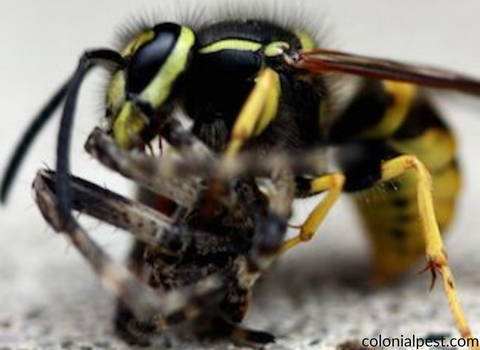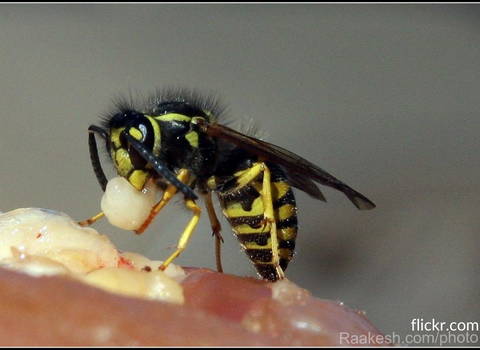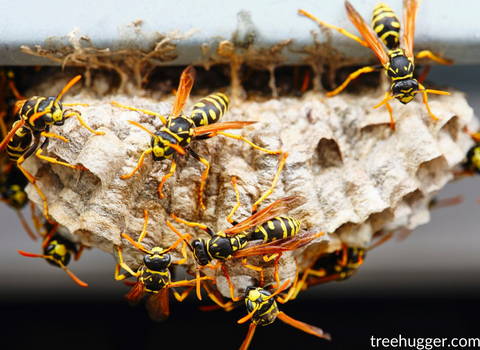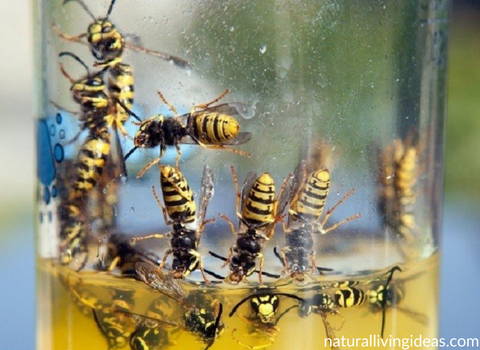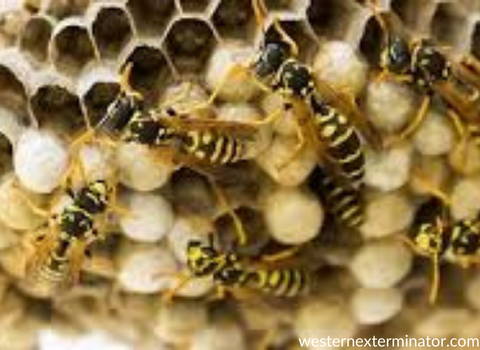What Do Wasps Eat?
Wasps are close cousins to bees and often look like bees because of their black and yellow colouring. There are approximately 30,000 various species of wasps and these include hornets and yellow jackets. Also, many wasps are not black and yellow.
Unlike bees, most wasp species use their stingers for catching food instead of stinging people. Therefore, you should be more aware that these insects will be lingering around you not to sting but to get food.
So, what do wasps eat? Understanding their diet and the types of food they eat will help you determine what attracts these insects in your home. You should know how to repel them and prevent them from infesting your home or garden.
Read the rest of the article to get to know more about wasps and how you should be dealing with them in case they infest your home.
Types of Foods that Wasps Eat
Different wasp species have different diets. Wasps usually feed their larvae bits and pieces of the insects that they have chopped up and killed. However, adults regularly feed on sugars they get from aphid honeydew, nectar, or the sugary liquid that is produced by the larvae.
Most wasp species are parasitic insects. This means that these species lay their eggs inside the bodies of other insects. These species rarely bother humans. Species that are often seen around humans are called social wasps and they always come searching for human food.
What do wasps eat in general? Check the list below:
Nectar and Fruit
Just like most insects, wasps also enjoy the sweetness of nectar and fruit. If your property has a single fruit tree or you have an orchard, the fruits will attract these insects. Aside from ripe fruits, rotten fruit that has fallen on the ground will also attract them.
Human Food
Wasps also love human food. It should not come as a surprise that these insects love the same food you eat. If there is a compost pile anywhere in your property or you tend to picnic anywhere in your property, expect that they will join you while eating.
Honey
When bees start becoming too productive, they will be susceptible to an attack by these wasps unless they made their hives strong. Wasps love honey and having beehives in your property will most likely attract these insects/ Now, you will have to deal with both the bees and wasps swarming in your property.
Honeydew
Honeydew is not the same as melon fruit. It is what develops when other insects such as aphids are done draining the sap of a plant or a tree. During this process, leftover sap looks like a small drop of dew and will hang from the backside of the insects.
Wasps will drink it right from the hindquarters of insects to feed. Yes, it sounds gross, but this is what feeds the wasps and prevents the bugs from dripping in other areas. When dripped in other plants or surfaces, it can become a sticky mess and will only attract more bugs.
Plants
Wasps are known to be beneficial to [plants. However, not everyone knows that wasps are great pollinators. They may feed on the nectar of some plants, but rest assured that your garden will blossom as wasps visit your flower beds.
Small Insects
Wasps eat a wide range of bugs or insects. Though many species focus mainly on nectar, fruits, or honeydew, most species are carnivorous.
They will eat other bugs or insects like:
Bees
Ants
Caterpillars
Beetles
Flies
Spiders
Aphids
Crickets
Sugar Cane Borers
Grasshoppers
Whiteflies
Cicadas
Species like the bald-faced hornets though only eat fruit nectar and juices. Yellow jackets, on the other hand, will eat “human food, and would often be found flying around garbage cans. There are times when wasps will make their way into the nests of bees and steal their honey.
Insects that Other Wasps Eat
If you are in North America, the mud dauber wasp is known as the common predator of spiders. Instead of eating spiders, these wasp species sting them, which paralyzes them and allows the wasps to put the corpse in the mud cell in the wasp nest. The larvae will all start feeding the corpse of the spiders.
Unfortunately, mosquitoes are not one of the preys of the wasp species. Wasps are commonly known for their ability to control the populations of spiders and caterpillars.
How about wood?
What do wasps eat? Do they eat wood? Species called paper wasps are known to chew wood pulp for them to create paper-like nests. If your home has wooden structures, you must create a wasp control plan. This way, you can prevent an infestation from happening before it gets worse.
Do they consume meat?
The wasp species known to feed on human food, such as meats are yellow jackets. They are also known to feed on other insects such as spiders.
With these in mind, you will have an idea of the wasp species swarming around your home or any part of your property and whether you should consider them bothersome or not.
What is a Wasp’s Diet Composed Of?
Just like all living things, wasps eat certain foods. These foods allow them to keep thriving. Solids and liquids will forage foods from different sources. This makes adult wasps omnivorous, or their diet is not restricted to a single nutritional source.
They often target flying insects on cattle, horses, flowering plants, and even meat products that are high in protein.
For most insects, adults are the only ones feeding the young ones. But with asps, larvae also feed adults. This unique reciprocation is another food source that is a critical reason why wasps are loyal to their brood or larvae.
Whenever the wasps are feeding the larvae, they reciprocate it by feeding the adults through trophallaxis. This process is when the larvae are producing a clear liquid that is believed to contain sugars and amino acids.
The substance acts as wasp caffeine, which makes them more aggressive. Adults are starting to outnumber the larvae when the nests are maturing. The shortage means that they need to be more aggressive.
As the nests continue to mature, the wasps will become less dependent on the nest for their nutrition source. You will most likely find drunk wasps or those disoriented wasps because of overconsuming alcohol-laden fruit juices in early autumn or late summer.
When the food sources start to go low and the last batches of larvae pupate and become queens and males, the nest will become dormant, and all wasps will abandon it.
What is a Wasp?
Wasps are insects are narrow-waisted suborders Apocrita of the Hymenoptera order, which is neither an ant nor a bee. This order excludes broad-waisted sawflies that look like wasps but belong in a different suborder.
They do not constitute a clade, a complete natural group that comes from a single ancestor, because their common ancestor is shared by ants and bees. Wasps that are included in the clade Aculeata can sting their prey, such as insects.
Two of the most known wasps are the hornets and yellow jackets that both belong in the family Vespidae. These are also known as eusocial, which means that they live together in a nest with one egg-laying queen along with non-reproducing workers.
Eusociality is favoured by the unusual haplodiploid system when it comes to sex determination in Hymenoptera. This makes sisters exceptionally related closely to each other. Still, most of the wasp species are considered solitary, which means adult females are breeding and living independently.
Solitary and Social Wasps
Solitary and Social are the two main types of wasps. All species are divided into these two types and will help you understand where the wasp species in your property belong.
Solitary
These wasps are species that have only one female in their colony that is raising her young. Varieties that are included in this type are non-stinging. This means that you do not have to worry about getting stung by solitary wasps.
Social
On the other hand, social wasps are living together in a large nest and often include the stinging species. Yellow jackets, for example, are social wasps that when bothered can give you a painful sting.
Both types are known as carnivorous in their younger years, which means they eat other insects. When they become adults, they use the stingers for paralyzing other spiders and bugs to catch the insects. This allows them to bring the insects in their nests. These insects will be fed to their young.
Are Wasps Beneficial to Gardens?
What do wasps eat? Will you benefit from their presence?
Though the sight of wasps swarming around your home or property is frightening because you will never know if they will sting you or not. You should also know if these insects are beneficial to the gardens and whether you should completely get rid of them or just control their populations.
Yes, you may have to run around when there are wasps around you, but if you consider yourself an avid gardener, you should know that wasps are your garden’s friends. Since they eat plant nectars, flying around your garden increases the chance of having a more beautiful and productive garden because they are pollinators.
Aside from helping in pollination, they also benefit your garden by getting rid of insects that are harming your plants. Being carnivorous, they can eat as many insects as they can find in your garden. This leaves your garden with little to no damage from other insect pests.
In other parts of the world, some farmers even make use of wasps to protect their crops. What they do is that they release the wasps in their crops and let the wasps eat other insects threatening to damage their crops.
If you need wasps in your garden, you can try to attract them by creating a pollinator garden. Do this by incorporating certain plants that they love. Some of the plants you can include are sweet fennel, spearmint, and Queen Anne’s Lace.
How to Get Rid of Adult Wasps
Not everyone wants the presence of adult wasps in their gardens. If you are among these people and want to get rid of them, the following are some of the things that you can do:
1. Put Sugar and Water Traps
You can create a simple wasp trap by making a water and sugar solution and put it inside an open bottle. This sticky mixture will be an attractant and adult wasps will crawl inside it. They will be trapped inside and eventually die.
There is a wide range of wasp traps that you can try for this instead of a DIY trap. You can use any of those and learn which one works to your advantage. Some have removable tops that will allow you to release the wasps once they get trapped.
However, if you choose to do this, bear in mind that the wasps will not be in their best mood. Be extremely careful to avoid getting stung and suffer from an allergic reaction afterwards.
2. Use Soapy Water
Another solution is using dishwashing soap. The soap will clog the breathing spores of the wasps and kills them quickly. Since you cannot swat the nest, you can try spraying the wasps one by one with the mixture.
You can also try to use soap suds by putting some dishwashing liquid at the end of the hose pipe, and once the soap suds appear, turn the water pressure on high so you can blast the wasp nests with the mixture.
3. Call an Expert
When all else fails, you can simply call a pest control specialist to help you with the wasp infestation. This way, pest control experts with experience will be dealing with the infestation and save you from getting stung.
below are products you can alternately use to trap wasps and keep them out of your property:
How to Prevent Wasps from Infesting Your Home or Garden
Once all the wasps are completely removed from your property, you can start doing some preventive measures to avoid another infestation. You want to make sure that you will follow and keep on doing these tips to make sure that these pests will not come back.
Always shut the doors and windows to prevent these insects from entering your home.
Limit their food source by making sure that garbage bins and food storage have tight lids.
You can also avoid planting bright coloured flowers as these attract them and avoid including plants that wasps love.
Schedule an appointment for a wasp inspection just to make sure that these pests have completely left your property.
These are just some of the tips that you can consider doing on your property. Following these will help you prevent a re-infestation and keep you and your family safe from the wasps’ painful stings.


